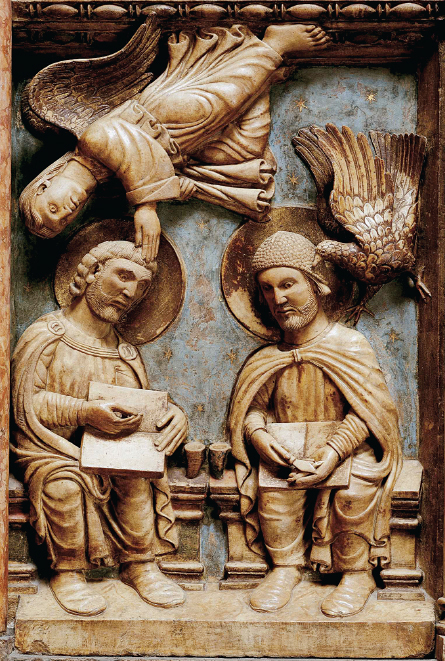Understanding World Societies:
Printed Page 211
The Western Church and the Eastern Church

This wood carving shows Saint Ambrose and Saint Jerome, two of the most important early church fathers, hard at work writing. Divine inspiration appears in the form of an angel and a dove. (Duomo, Modena, Italy/Alinari/Art Resource, NY)
The leader of the church in the West, the bishop of Rome, became more powerful than his counterpart in the Byzantine East for a variety of reasons. Most significantly, bishops of Rome asserted that Rome had a special place in Christian history. According to tradition, Saint Peter, chief of Jesus’s disciples, had lived in Rome and been its first bishop. Thus, as successors of Peter, the bishops of Rome — known as popes, claimed a privileged position in the church hierarchy, an idea called the Petrine Doctrine. They urged other churches to appeal to Rome for the resolution of disputed issues and sent letters of guidance to other bishops. (The Christian Church headed by the pope in Rome was generally called the Roman Church in this era, and later the Roman Catholic Church.)
The popes also expanded the church’s secular authority. They made treaties with barbarian leaders, charged taxes, enforced laws, and organized armies. The Western Christian Church headed by the pope in Rome would become the most enduring nongovernmental institution in world history.
By contrast, in the East the emperor’s jurisdiction over the church was fully acknowledged. As in Rome, there was a head of the church in Constantinople, called the patriarch, but he did not develop the same powers that the pope did in the West because there was never a similar power vacuum into which he needed to step. He and other high church officials were appointed by the emperor. The Eastern emperors looked on religion as a branch of the state, and they considered it their duty to protect the faith not only against heathen outsiders but also against heretics within the empire. Following the pattern set by Constantine, the emperors summoned councils of bishops and theologians to settle doctrinal disputes. They and the Eastern bishops did not accept Rome’s claim to primacy, and gradually the Byzantine Christian Church, generally called the Orthodox Church, and the Roman Church began to diverge.